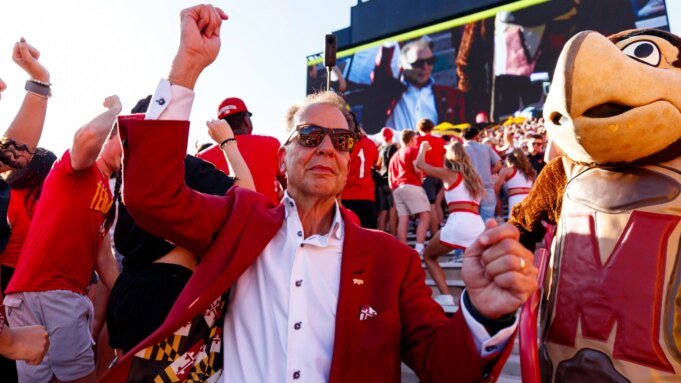Maryland’s new regime has vision to spare and lofty goals — but now comes the expensive part

COLLEGE PARK, Md. — Two years ago, Maryland hosted Indiana on a beautiful late September day where everything seemed to be working for the Terrapins.Mike Locksley’s Terps crushed Indiana, 44-17, to go 5-0 on the season and all but end the Tom Allen era in Bloomington. Quarterback Taulia Tagovailoa was terrific, throwing for 352 yards and five touchdowns to lead a Maryland offense that looked unstoppable. As Indiana made its first return trip to College Park last month since that loss, a lot has changed in college football. With schools now allowed to spend up to $20.5 million in direct payments to athletes under the House settlement, there appears to be more parity than ever. Sure, the usual blue bloods like Ohio State, Alabama and Georgia are still atop the rankings, but it has opened up a path for non-traditional programs — like Indiana. The Hoosiers this time blasted Maryland, 55-10, in front of a sellout crowd inside SECU Stadium. Two years earlier, Maryland fans were dreaming big about what a 5-0 season could portend; now they were chanting for coach Mike Locksley’s firing.
Indiana is the best example yet of what’s possible in this new world. The Hoosiers are currently ranked No. 2 in the College Football Playoff Rankings and are on pace to get a first-round bye. Indiana coach Curt Cignetti is a remarkable 21-2 in only two seasons. What Cignetti has done at Indiana is both a blessing and a curse for programs everywhere, especially like-minded ones such as Maryland, which carry basketball-school monikers but recognize football is the financial engine that pays for everything. If Indiana and Cignetti can do it so quickly, why can’t we? Maryland’s new athletics brain trust wants a little more runway than Cignetti’s remarkable two-year turnaround but has similar lofty goals of what’s capable at a school frequently referred to as a sleeping giant.
“If we’re good with a three-year plan, which is what I’m working with, then I think we’re in the top tier of the Big Ten within three years in football,” Maryland AD Jim Smith told CBS Sports two weeks ago.The big question: How?The new man with the new, inspired planMaryland’s new AD had previously been SVP of business strategy for the Atlanta Braves.
Maryland Athletics
Jim Smith is everywhere on Maryland’s campus, documenting it all along the way on his Instagram account. In just the last two weeks, there are photos with Terps legends like former basketball coach Gary Williams, ESPN personality Scott Van Pelt and former football player Domonique Foxworth. Smith is the energetic and charismatic leader of a new-look Maryland athletics department, hoping to elevate the Terrapins to the next level. The first-time athletic director, who arrived on campus in July, is part of a new infusion of those from the professional ranks seeking to modernize a college sports industry where money has never been more paramount. For a school that has long lagged behind its peers in that department, Smith was hired to be a rainmaker.
Before Maryland, he worked as senior vice president of business strategy for the Atlanta Braves. But over the years Smith has been everything from the president of the MLS team Columbus Crew to the president of the Ohio State alumni association to a former WWF executive under Vince McMahon. He took the job after Damon Evans, who was AD from 2017 to 2025, left in March for SMU. Surrounding Smith are new hires of senior deputy athletic director Diana Sabau and deputy athletic director and chief revenue officer Joe LaBue. Sabau, who most recently was Utah State’s athletic director, has known Smith for decades. Sabau is an experienced college sports executive, having also served as Gene Smith’s deputy at Ohio State and as the Big Ten’s deputy commissioner. LaBue’s background is similar to Smith’s, having most recently served as president of Charlotte FC. He’s worked primarily in professional sports, including stints with the Carolina Panthers and then-Washington Redskins. He knows the unique terrain of the job as a Maryland alumnus. The triumvirate is only a few months on the job but is earnestly trying to wake up a Maryland football fanbase and get more people out to the games. They created Terpsville Fan Fest, a family friendly fan activation featuring face painting, inflatables and other activities that lets fans into the state-of-the-art Jones-Hill Field House before games. They’ve worked to improve parking, concession opportunities like Octoberfest offerings for a home game against Washington and unique souvenirs like a limited-edition Yeti tumbler sold against Indiana for homecoming.
The measures are working, but they haven’t been easy. A 4-0 start to the season imploding into a 4-5 season dampens fan enthusiasm — a long-standing problem for Maryland, even on the best days. An oft-repeated issue is that Maryland is between Baltimore and Washington, D.C. While it may be great for alums looking for jobs in major cities, it puts Maryland up against the Baltimore Ravens, Baltimore Orioles, Washington Commanders, Washington Capitals, Washington Nationals and Washington Wizards for fan attention and money. It has been a real challenge for the school to navigate in the past — and an easy excuse for previous administrators — on why Maryland couldn’t get more fans out to a Saturday game. Call it knowledge or optimism, but Maryland’s new leaders are all in lockstep that those professional teams don’t have to be as significant an impediment as they’ve been made out to be in the past. From Smith on down, the mentality has shifted to say-yes-then-find-a-way. It’s what has already made Smith and his new team popular with Maryland fans. “I’ve heard too many times in two months here we’re a college sports program in a pro sports town,” LaBue said. “To me, the value prop we have is just as strong, if not stronger, than any of the pro sports teams in the area, and the area is big enough and diverse enough to support all of us.”
For Smith, who has spent most of the last two decades in a pro sports town in Atlanta, there are actually advantages to knowing the Commanders and Ravens have rabid fanbases. You don’t have to convince people to enjoy football; you know they are all out there. “What I’ve learned is 14 million people live within 100 miles of College Park,” the Maryland AD said. “When you start talking specifically about football and how far people will travel, that is a huge number of potential fans to develop. There really isn’t a lot of competition for Division I football in that radius, so it gives us, what I believe, is a strategic advantage.”The upside is high. There’s plenty of state pride in Maryland — ask any Marylander about the state flag — but the key is getting more to embrace the flagship state university. That includes an undergraduate enrollment of more than roughly 30,000 students and more than 420,000 living alumni. Right now, that is about getting them to show up to games. More fans not only equals more short-term revenue but can also help Maryland better position itself with potential corporate partners and advertisers in a competitive market. The revenue potential on ticket sales alone could be huge.
Even if Maryland had outsized demand, its stadium capacity of 51,802 is going to hold it back compared to the 100,000-plus stadiums at Michigan, Ohio State and Penn State. But the gulf between the top tier of the Big Ten and Maryland is massive — far more than double. Maryland made $14.83 million off ticket sales in 2024, according to Knight-Newhouse data, while Michigan and Ohio State both crossed the $58 million mark. It is a reminder of Maryland’s life in the Big Ten that even if it boasts healthy enrollment numbers and a wide swath of living alumni, it is disadvantaged against the rest of the conference when it comes to the most basic of all scholastic numbers. In the Big Ten, only Iowa, USC, Oregon and Northwestern had fewer undergraduate students on their main campuses, according to fall 2024 numbers. At the top is Ohio State with more than 45,000 undergraduates enrolled. Maryland boasts healthy enrollment numbers in a vacuum, but it lags behind other Big Ten universities.
Getty Images
The new Maryland mindset, though, is not bemoaning what you don’t have but capitalizing on what you do. That is why people like LaBue and chief development officer Kirby Mills, another alumnus, are devoting so much time and energy to engaging fans and trying to get them in the building. As the former vice president of ticket sales for the Panthers, LaBue is using every skill he has to make it happen.
“There’s no room for failure,” he said. “Being status quo is not OK. We’ve never operated that way. I think Jim’s seen me a couple times the last last two months, and he’s like, ‘Dude, you look like you’ve got the weight of the world on your shoulders.’ I said, ‘Jim, I’m sorry, it’s the only way I know how to operate.” What everyone knows, too, is that the better the product, the easier an ask that is. The challenge, as the Terps’ new brain trust has quickly realized, is that Maryland football fans are accustomed to being disappointed just when they get their hopes up. It’s a real-life embodiment of Lucy pulling the football away from Charlie Brown. It’s evident in the differences between “September Maryland” and “October Maryland.” The Terrapins went undefeated (4-0) in September and are 18-3 in September games since 2021. In that same time period, Maryland is 5-12 in October games. After the loss to Indiana, Maryland now has the fourth-longest losing streak to ranked conference opponents in college football history, dating back all the way to 2011.
Sabau says it hurts her heart that when people talk about October Maryland, they aren’t talking about great weather and beautiful fall foliage but the football program’s on-field struggles. She, like her peers within the department, knows they have to find a way to get Maryland fans to believe in the vision. “I think it’s like shedding that scar tissue, which is a lot easier said than done, and really believing,” Sabau said. “You have to believe every time we start a game … that we have the ability and we have the resources to win. Whether that’s trusting our head coaches or trusting the talent they’ve recruited and brought in, we have to believe. If we don’t believe it, then we’re really going to have a lot heavier lift.”The looming question, growing bigger with every on-field loss, is whether there is still belief in the current football leadership to do it.
How much does Maryland need to spend on football?At the very top of the evaluation of what Maryland football should and can be is the resources question. Is Maryland spending enough, both institutionally and as a fanbase, to make football successful?When looking at Indiana, there are different ways to assess its success. You can highlight that the Hoosiers hired a man who appears to be a transcendentally talented football coach, Cignetti, who has elevated the program beyond even its fans’ wildest dreams. Or you can focus on Indiana deciding it wanted to improve in football, significantly increasing its financial investment and giving Cignetti the resources he needed to succeed. “Indiana started a plan about four years ago,” Smith said. “They started investing in football a while ago and then they got Curt and then it skyrocketed. It wasn’t hire a coach and everything’s going to be OK. Put all the things in place to be successful and that’s what they’ve done.”What is striking about Indiana is how far it has come in just a few years. In 2021, Indiana had the fourth-lowest total in Big Ten football spending at $23,938,827. That number jumped to nearly $32 million in 2022, $34 million in 2023, and then a massive leap to $61.58 million in 2024, the first year of Cignetti. Maryland had its significant jump from 2021 ($20.49 million) to 2022 ($30.8 million), but is still well below the top of the conference. Erstwhile basketball school Indiana is spending 157% more than what it did in 2021; Maryland is spending 30% more.
CoPilot
Of the Big Ten’s 16 public universities (excluding USC, Northwestern), only Purdue ($31.38 million) spent less than Maryland ($37 million) on football in 2024, according to the Knight-Newhouse database. The average total football spend of the 16 schools was $58,207,106.30. If you bundled the old “Big Ten East” teams together, Maryland spent less on football in 2024 then all of them. Rutgers, which joined the Big Ten concurrently with Maryland, spent $64.4 million on football — nearly double. Indiana’s increased spending not only attracted Cignetti but it allowed him to bring his James Madison staff with him. And after a wildly successful first season in which rival programs tried to poach defensive coordinator Bryant Haines and strength and conditioning coach Derek Ownings, Cignetti had the money to keep them. That 2024 season even got billionaire Mark Cuban, an Indiana alumnus but long a reluctant sports donor, to invest significant money to keep the Hoosiers’ good football fortune going. For Maryland, that support has long come from Under Armour founder Kevin Plank. The athletic apparel company executive chairman has donated significantly to his alma mater over the years, including a $25 million gift for the Jones-Hill Field House. He’s at a very different stage of his career and life than Nike co-founder Phil Knight, but what Knight has meant for Oregon football, especially in the NIL era, shows the outsized impact one individual can have. At minimum, Plank’s Baltimore-based Under Armour company recognizes the value of Maryland athletics to the state. Maryland’s new leaders are actively working to come up with ways to maximize the potential for both parties. “I know that Kevin Plank has been the best partner to this institution, to athletics, and he really deeply believes in the success of Michael Locksley and the football program,” Sabau said. The Mike Locksley conundrumLocksley is popular with players, but a losing spell has fans frustrated.
Getty Images
Ahead of what was an eventual loss to Indiana, Locksley was still optimistic about Maryland football’s future under his stewardship. In his spacious office inside Jones-Hill Field House, surrounded by reminders of a successful football life, Locksley laid out what Maryland had been and what it could still become. He wasn’t any happier about the losing streak than any frustrated Maryland fan was, but he still saw a young team making progress. He likened it to a turtle slowly pressing forward to win the race. The three consecutive last-minute losses to Washington, Nebraska and UCLA were heartbreaking in many ways, but Locksley, a disciple of Nick Saban’s process-oriented approach, still saw a team doing a lot of the things good teams do to be successful. Before the loss to Indiana, Maryland even led the country in turnover margin. Locksley believed, though, that more financial resources were necessary if Maryland wanted to be part of the neighborhood in which Indiana now resided. Maryland has long been stuck in the middle, a Power Four program with plenty more resources than Group of Five schools but less than many of its power peers. That has only been amplified in the NIL era where Maryland has lagged far behind the top of the sport. Lockley would point to a spending gap to partially explain an 8-13 record beginning in 2024.
CoPilot
In his first meeting with Smith, the Maryland football coach told his new boss he needed “recovery modalities” for a team he knew was going to be short on depth. “We have been and had been resourced to go to bowl games every year,” Locksley told CBS Sports. “Right now, we have enough resources that we should go to bowl games every year. That’s not my goal anymore. My goal is to try to get into the playoff and try to compete for Big Ten championships. Being resourced to go to bowls and being resourced to win championships and take that next step are different resources.”Locksley inherited a difficult job when he took over in 2019, taking over a football program still grappling with the tragedy of football player Jordan McNair’s death. The first two seasons, which included the COVID-19-impacted 2020 year, were incredibly challenging, but he found his stride in 2021. For three consecutive seasons, Locksley won at least seven games, won a bowl game and had Maryland football on an upward trajectory. He developed and produced multiple NFL players including first-round pick Deonte Banks. Locksley raised the bar and made Maryland football respectable again. Then came a step back in 2024 with a 4-8 record that prompted Locksley to do a staff and roster overhaul, bringing in six new full-time coaches including offensive coordinator Pep Hamilton and defensive coordinator Ted Monachino and 64 new players. The Terps got off to a hot start but are now 4-5 with a trip to Illinois on deck. Optimistic fans would say Maryland could easily be 7-2 after losing three games by a combined 10 points. In that scenario the conversation would be around extensions and raises for Locksley rather than whether he’ll be the coach next season. That’s how close the margins can be in this era when James Franklin can coach Penn State in a College Football Playoff national semifinal and still be fired 10 months later. Locksley knows the reality of the life he’s signed up for in college football. In a conversation with CBS Sports two weeks ago, he expressed his belief he was doing everything he could to make Maryland football successful. “If it isn’t good enough, I’ve done my best,” Locksley said. “That’s the part of me for as a coach finally I’m OK with I’ve done my best, I’m doing my best, I will continue to do as much as I can to figure it out.”The new boss, Smith, has preached patience. He knows that isn’t necessarily what fans want to hear, but the pragmatic AD was hired to be different and that includes not being in a rush to follow his peers in doling out an eight-figure buyout. He told The Baltimore Sun earlier this week that Locksley would, at minimum, finish out the season and evaluations would come afterward. In a message to CBS Sports on Wednesday, Smith said, “This is a process and I am confident in Locks, our coaches and the young team we have as we enter the last quarter of the season.” The glass half-full look at Maryland focuses on a young talent base of freshman quarterback Malik Washington and defensive players Sidney Stewart and Zahir Mathis. The nation’s No. 3 overall recruit Zion Elee is committed for next season. If Elee, a 6-foot-4, 220-pound defensive end from St. Frances Academy, signs with the Terrapins next month, he’d be the highest ranked football signee ever.
Locksley has long been the pied piper of D.C.-area recruiting, and the fear is that not only would those players hit the transfer portal if Locks was fired but that any replacement could have difficulty replicating his recruiting success. The flip side is that the countless hours spent trying to get Maryland fans invested again in football would be for naught if fans don’t believe in the product. It’s hard to convince fans Maryland will be in the top tier of the Big Ten in the next three years if the Terps are coming off back-to-back eight-loss seasons. It’s what makes the next three-game stretch so critical not only for Locksley, but for the entire department. Maryland is desperately trying to get a fanbase to buy back in, but needs to reward its fans. A road loss to Rutgers last Saturday, in which Maryland gave up 35 points and 485 offensive yards, was a significant blow to the Terps’ bowl hopes. Now, Maryland must find two wins against Illinois, Michigan and Michigan State to not only go bowling but to potentially save Locksley’s job. Fan frustration is high after the Rutgers loss, but there are those around the program that believe with increased financial investment, Maryland could not only retain its talented young nucleus but surround players like Washington with more talent. It would also allow for Maryland to avoid wading into what has quickly turned into a wild coaching cycle. If Maryland were to fire Locksley, which would come with a more than $13 million buyout, it’d compete in a market that already includes Auburn, Florida, LSU, Penn State, Arkansas, UCLA and Virginia Tech. Clearing out the coaching staff comes with more millions, and that’s before you even factor in a new hire who could command more than Locksley’s $6.1 million annual salary. At football-rabid SEC schools, there are big boosters eager and willing to stroke huge checks to dump a struggling failing coach. In some ways, the job of the AD of those kinds of schools is to calm down the booster base to hold on to their money. Maryland is different. The school has some big boosters, but they are largely hands-off and generally unwilling to kick in millions to pay for a big buyout. A $13 million buyout might feel paltry compared to the $54 million LSU is currently on the hook for with Brian Kelly, but it isn’t easily raised at Maryland. It puts Smith and his new brain trust in a tricky spot just months into their tenure. The rank-and-file Maryland fans may want Locksley gone, but the big money hasn’t followed yet, sources told CBS Sports. There is talent on the roster to be excited about, but Smith must decide whether the current coaching staff is maximizing it. It all adds up to Maryland being at another inflection point. Maryland desperately wants to follow in the footsteps of Indiana and others to become more than it has historically been. Does that mean pouring more money into the football program? Hiring a new coach and hoping for better results? Both?The path Smith and his team choose over the coming months could forever change the trajectory of Maryland football.
已发布: 2025-11-13 17:17:00










